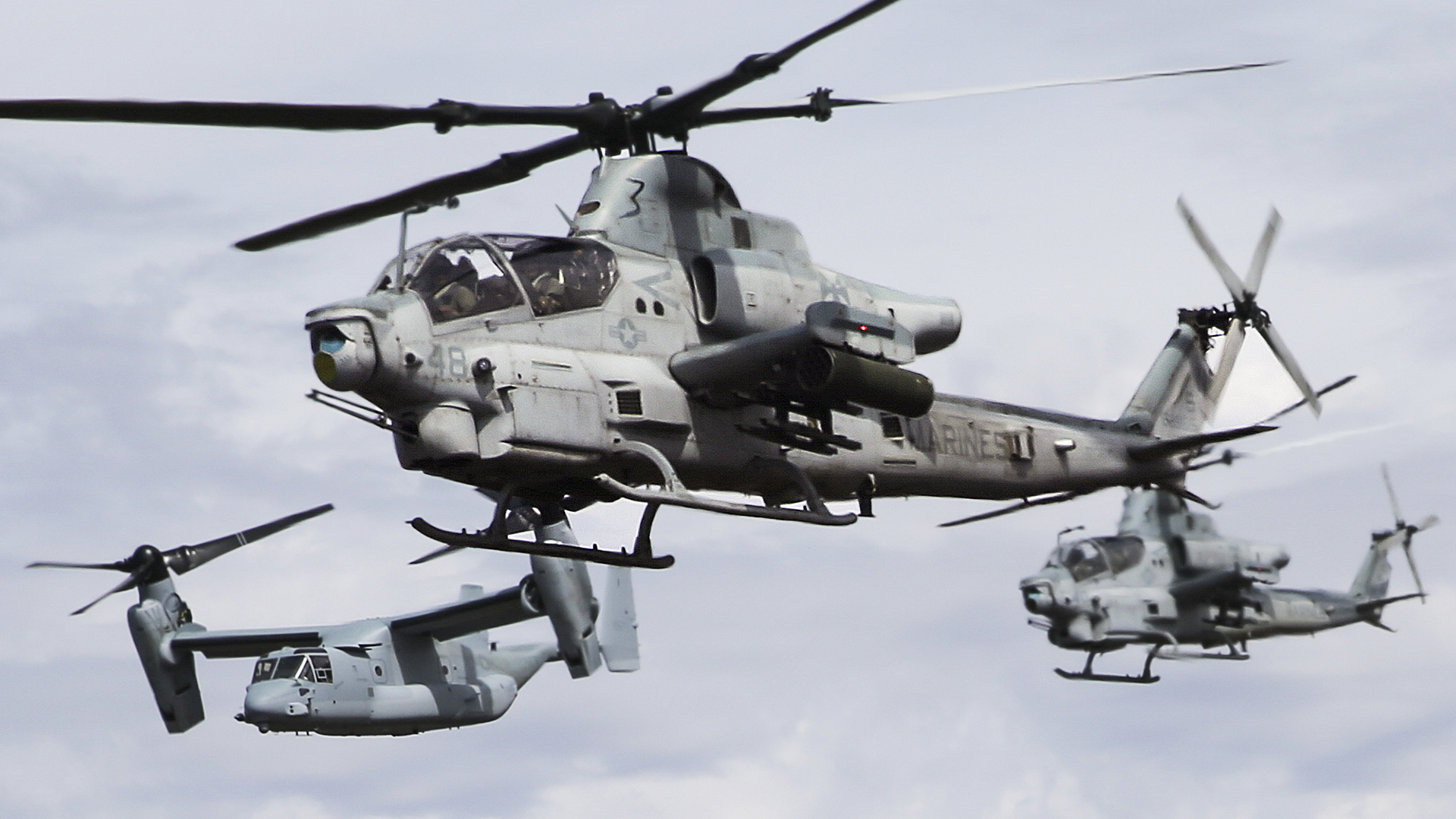The Marines are rapidly preparing for a huge fight in the Pacific — one that will be a big departure from operations in Iraq and Afghanistan over the last two decades. This will require a whole new set of skills and capabilities, and by every account it won’t be a cakewalk. Maybe the best showcase of this momentum-gathering sea change for the Marine Corps is how the 3rd Marine Air Wing (3rd MAW) teamed up with the 1st Marine Division and a host of naval vessels for exercise Steel Knight. This sprawling war game focused on training Marines and sailors to fight their way into and operate out of high threat weapons engagement zones similar to the combat environment they could find themselves in during a peer fight in the Pacific.
Earlier this week, the 3rd MAW, which is based near San Diego, finished its participation in exercise Steel Knight 23, which ran from November 28 through December 15. The event is the 1st Marine Division’s annual large-scale exercise, which is seen as the final major training event for the 1st Marine Expeditionary Force (MEF) before they deploy as part of Marine Rotational Force Darwin in Australia.
Forgoing their own large exercise known as Winter Fury (read our previous report on that exercise here), 3rd MAW leaders decided that by having a larger aviation presence in Steel Knight 23, they could better align themselves with the commandant’s vision laid out in Force Design 2030. Steel Knight was an operation that the MEF and 3rd MAW used to develop and validate their concept of operations in the Pacific. Missions included a 2,300-mile long-range simulated strike by Marine F-35Cs, as well as a host of sea denial missions including deploying AH-1Z attack helicopters armed with the new Joint Air-To-Ground Missile (JAGM) from Littoral Combat Ships.
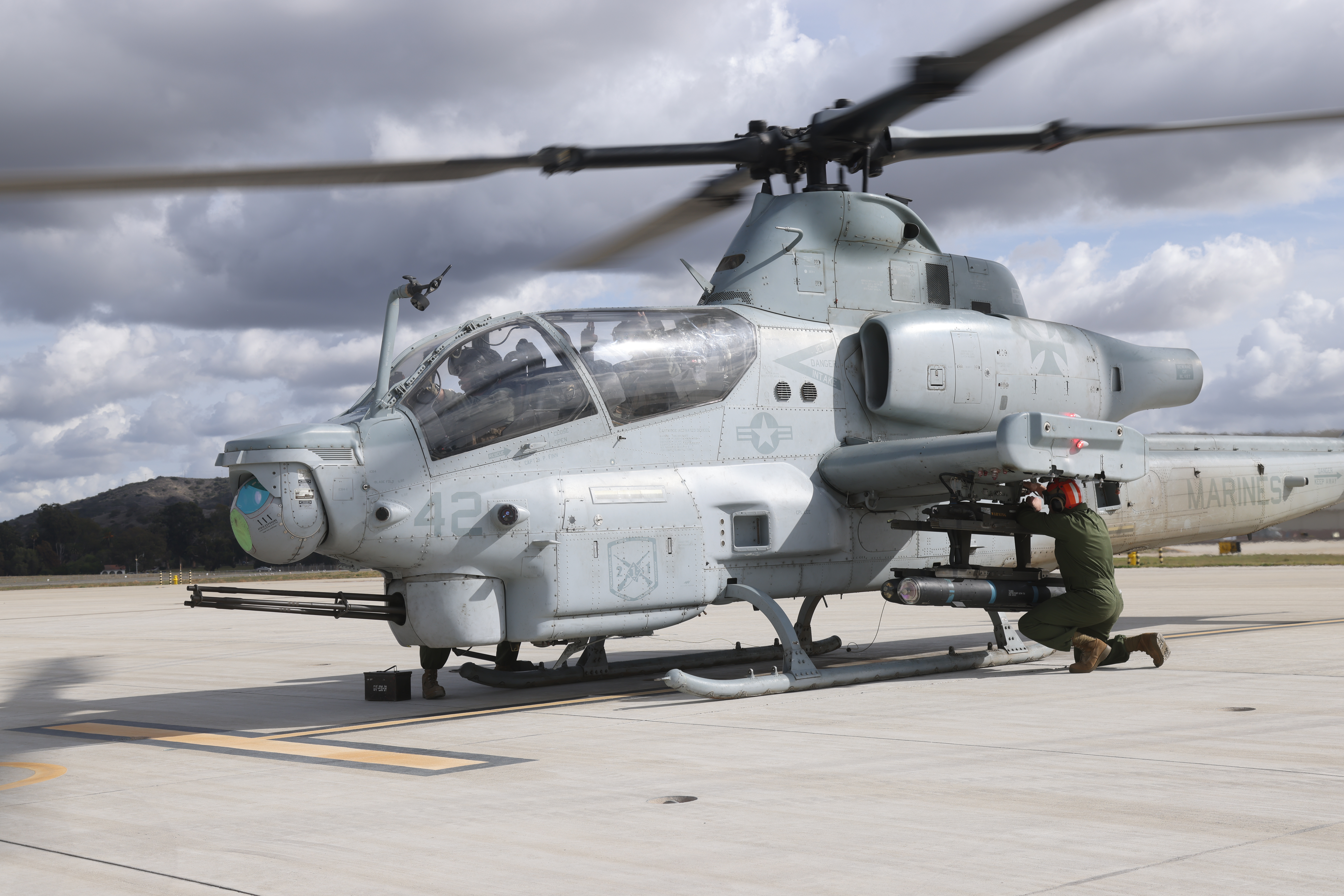
Brigadier General Robert Brodie serves as the Assistant Wing Commander for 3rd MAW. He told The War Zone, “We split Steel Knight into two things. The first was an MRX with live fly and then a CPX which was simulated. Our simulated exercises typically are really focused on command and control and coordination from staff to staff making our battle rhythm run. What I am particularly focused on with respect to Steel Knight is the development of the Air Tasking Order. We are taking all the requirements that the MEF would levy in a real-world situation and prioritizing what aircraft are going where and when in order to make sure the division is supported in their maneuver.”
“For the live portion we have set up miniature EABO points where we set up fueling and arming or maybe a command and control sight. We are trying to do these things at an increased cycle and speed where we are flexible and adaptable and we keep moving. So the more we can do that, the more we can push power at a higher rate,” Brodie indicated.
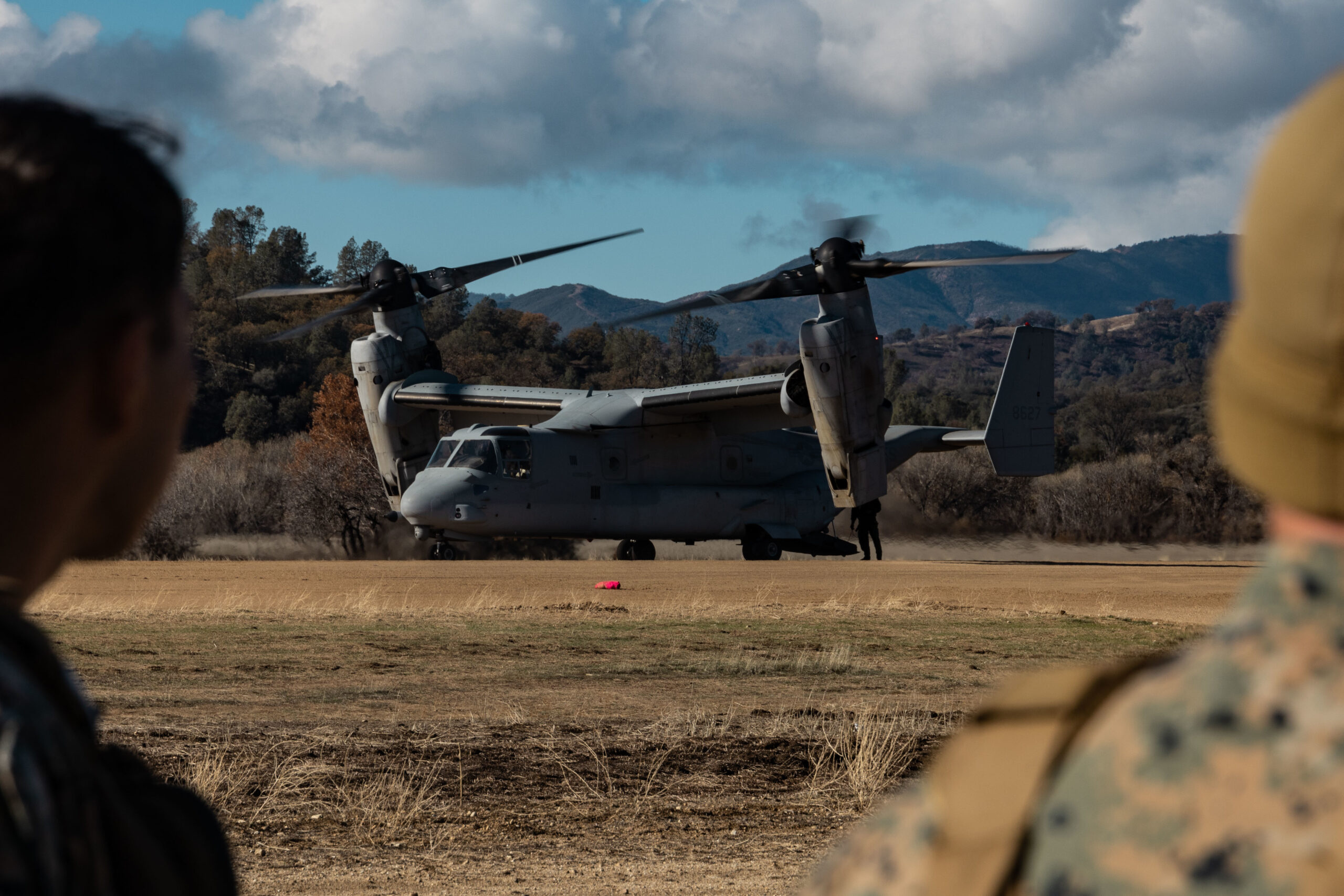
Using the great training areas both on the ground and in the waters off the coast of southern California, planners for Steel Knight 23 tried their best to challenge the military to fight over vast distances against a near-peer adversary with a heavy focus on sea denial missions. The operating area covered over 60,000 square miles which helped to represent the challenges military planners face in the Indo-Pacific. The U.S. Navy and Coast Guard integrated into the exercise, providing several ships and submarines to both assist the blue (allied) forces as well as to act as enemy vessels using special emitters to simulate what our forces would see in the real world.
Steel Knight 23 began with MV-22Bs moving Marines from the 1st Marine Regiment to Fort Hunter-Liggett, which is located about 300 miles north of San Diego. Marines quickly set up a main operating base and a command and control (C2) node. From there, Marines went to work setting up other locations including on San Clemente Island and also on board the USS Tripoli (LHA-7) which just returned from its maiden deployment. Tripoli was used as an operating base for AH-1 and UH-1 helicopters.

Captain Andrew ‘Musk’ Sperry serves as the Future Operations Officer of Marine Air Group-39, which is based at Camp Pendleton, and had several of its H-1s and MV-22s squadrons participating in the exercise. He told The War Zone, “Steel Knight is a MEF level tasking with a training audience being the 1st Marine Regiment. We are working with several ships out in the Pacific in order to create a robust friendly and enemy naval picture. We have taken a few friendly naval vessels and said you are now the simulated enemy so go to this area and emit this much. The ships have the ability to go completely dark which complicates our weapon solution.”
“For MAG-39 which operates H-1s and MV-22s, our role in all of this is providing an attack platform with the H-1s and a command and control and digital operability with a possible torpedo attack platform with our MV-22s. Our H-1s are also doing SCAR which is Strike Coordination and Reconnaissance, and that is a major tactic used in sea denial. Taking the SCAR tactics we have used for decades and amending them to focus on naval threats is not easy. It changes the picture because we don’t have artillery anymore, we now have NEMESIS (Navy/Marine Corps Expeditionary Ship Interdiction System). We don’t have terrain to hide behind anymore because we are operating over the open water. Our safety is how low we can get but that comes at the cost of communication because our radios can’t reach as far,” Sperry noted.
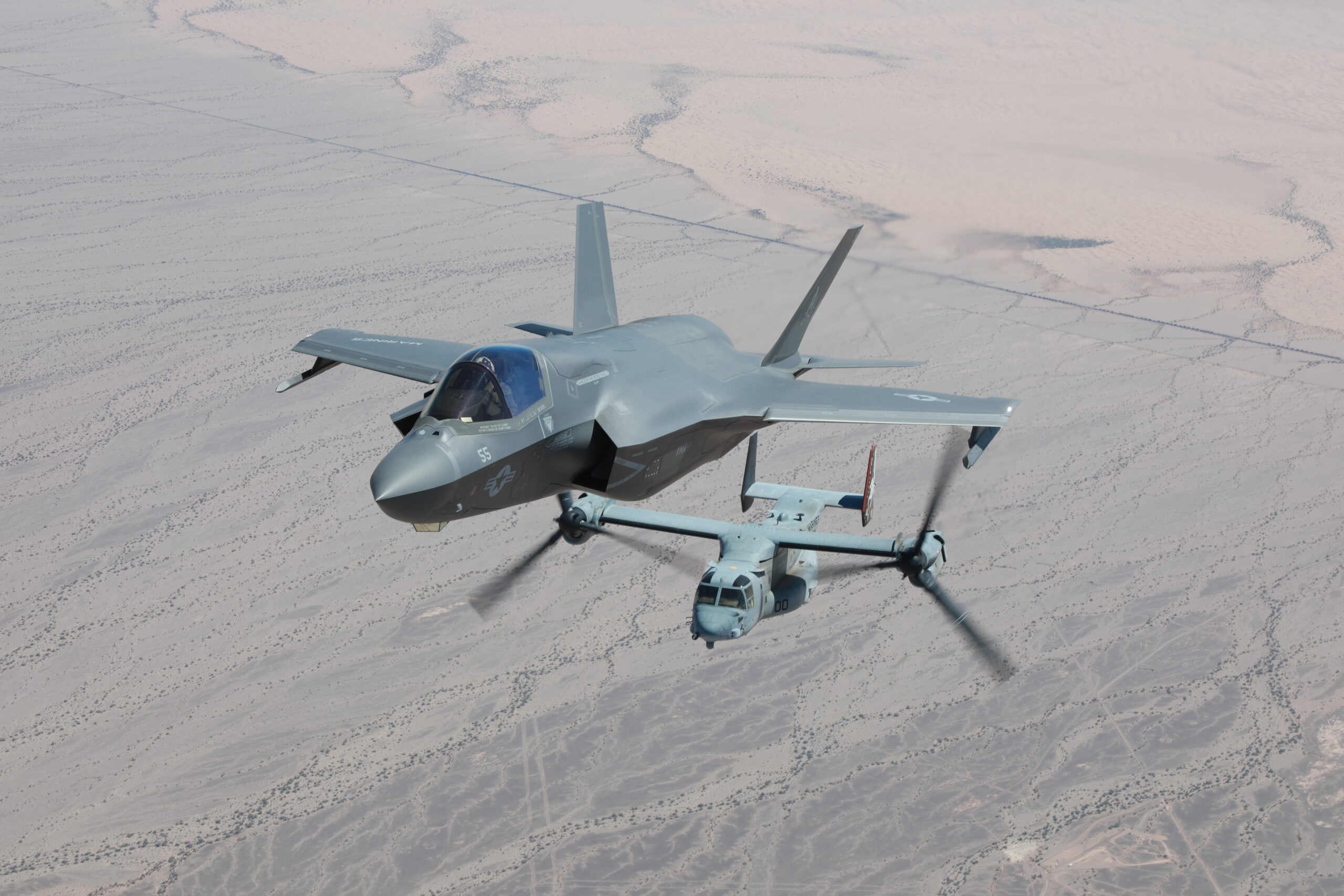
MAG-39 is about to overcome the issues with communication with others over long distances with the introduction of Link-16 to its H-1 aircraft in the next few months. Link-16 will enable the helicopters to effectively communicate with all of the other players and be able to receive target taskings. Sperry explained, “If we can get a target to us by Link-16, we don’t have to emit on the radio which keeps us safer and we can sneak in flying extremely low … at notch airspeeds with tactics to help avoid detection and shoot the most valuable parts of the ship and then fly away. We might not ever sink any enemy ship but if we can blow up all of their radar faces and we can drop a top-down missile onto their missile bay and we expend a $40,000 missile to blow up millions of dollars worth of cruise missiles, that’s a win that allows the Air Force and Navy to focus on the big level threats.”
During Steel Knight, MAG-39 focused on becoming part of the kill web and not the kill chain. On the kill chain, you might see a target but then you have to report it and await approval to attack it. The method is slow and ineffective, taking up valuable time. The kill web uses data advanced networks like ANW2 (Adaptive Networking Wideband Waveform) and Link-16 to speed things up. Sperry told us, “A Marine sitting at Fort Hunter Liggett, which is a C2 node during the exercise, could receive data that says they believe a ship is in a certain area. The Marine can text out through JREAP-C (Joint Range Extension Applications Protocol) to the Navy P-8 that is out flying during the exercise and uses its powerful radar to confirm that the target is in the area and that it is 81 meters long and has two superstructures and is proceeding in a certain direction. This is all happening over a network that everyone can see, so now as an H-1 I can see we have a ship that I can’t handle so I am going to start flying away from it and then assets like the H-60 Romeo can get a weapon ready to destroy the target.”

MAG-39’s Commanding Officer, Colonel Marve, told The War Zone, “Right off the coast, the Gunfighters (HMLA-369) and Purple Foxes (VMM-364) are fighting off the USS Tripoli. They are fighting Air Tasking Order line numbers in support of the MAGTF maneuver, which is headquartered at Hunter Liggett. They are using the ship as a steel lilypad. [For] Food, ordnance, and gas … and somewhere to sleep at night. They are fighting off that ship in support of the 1st Marine Regiments CO maritime maneuver to complete kill chains, reconnaissance, and … logistics.”
“The Tripoli is a big deck helicopter carrier but we have demonstrated that we can go do a cruiser or destroyer. It does not matter. During the exercise we landed on the Littoral Combat Ship USS Jackson (LCS-6) and validated if we were going out and stayed on the ship, how would you want us to land? How would you bring ordnance to us rather than just gas? We demonstrated that. We brought out a Cobra and a Huey and did all that. We have great relationships because we have the fleet right down the street and the MEF just over the hill.”
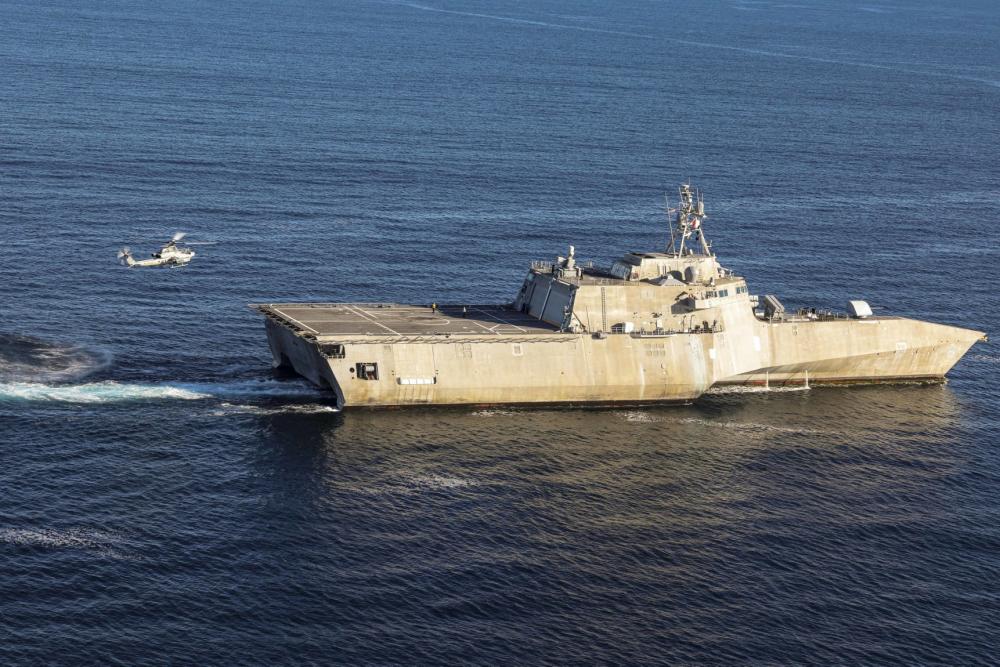
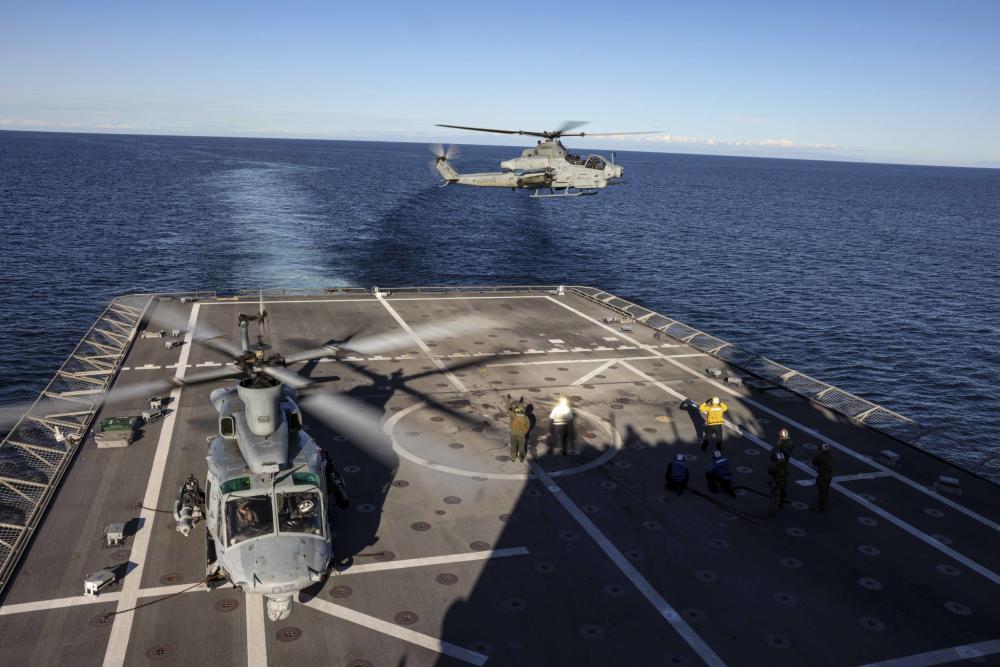
While operating off the USS Jackson, H-1 crews were able to team up with a Medium Unmanned Surface Vessel, an MQ-8C Fire Scout, and an MH-60S Sea Hawk, which significantly enhanced Jackson’s ability to conduct persistent, over-the-horizon search and destroy missions.
After the assault support phase of Steel Knight – where MAG-39 moved Marines about the battlespace treating it like an island maritime campaign – they moved to reconnaissance and logistics operations before going into the sea denial/sea control phase. This is when MAG-39 provided the regiment with what it would need from an Air Combat Element (ACE) using their H-1s to provide missions like Close Air Support (CAS) and armed reconnaissance.
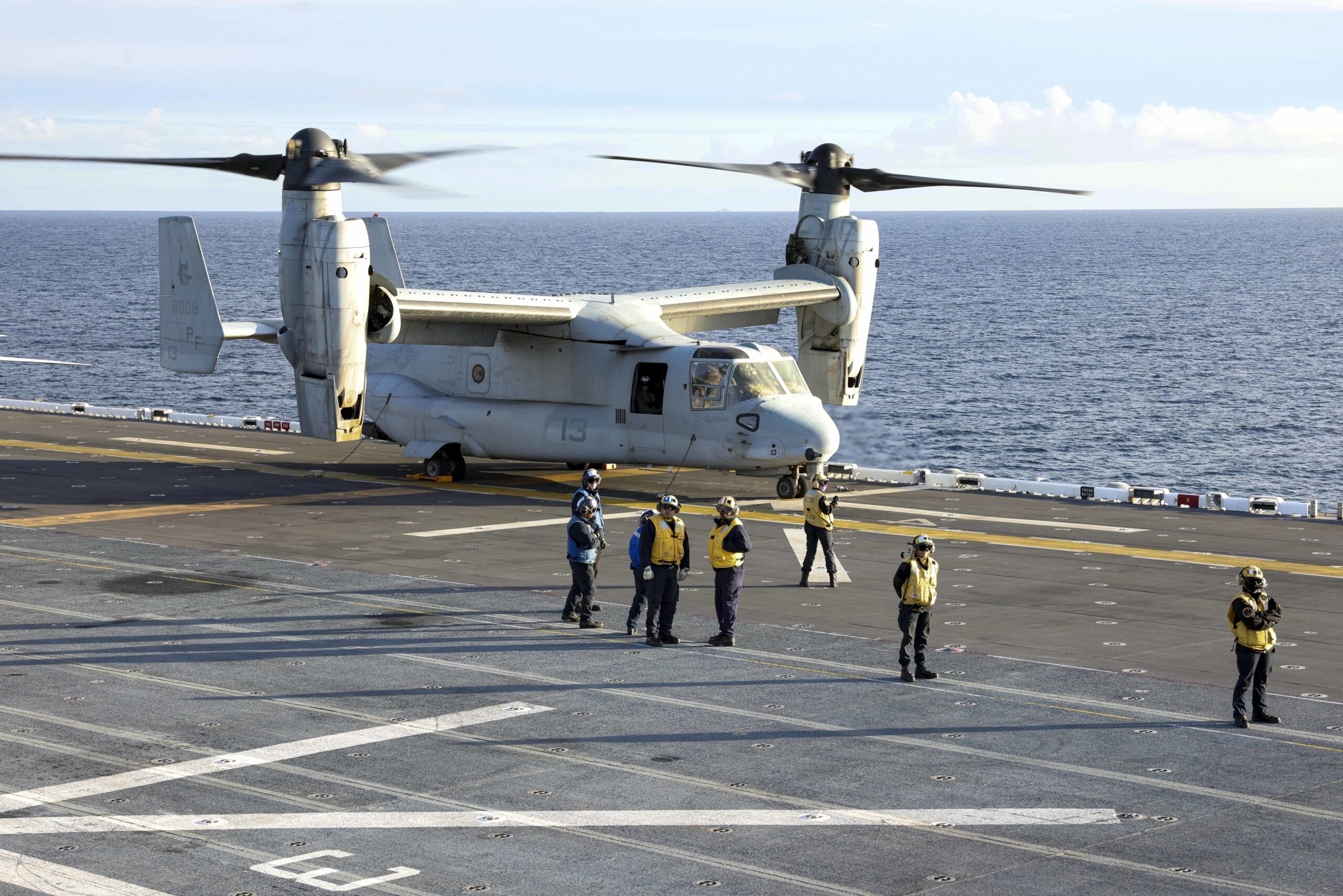
One of the more exciting parts of the exercise saw the Marines operational test squadron VMX-1, team up their F-35Bs with legacy F/A-18 Hornets from Marine Air Group 11 carrying AGM-84 Harpoon anti-ship missiles to attack an enemy surface action group. The mission, known as SAG Takedown (Surface Action Group), saw the squadrons working on the tactics, techniques and procedures (TTPs) to combine the power of the F-35 and its sensors with the Hornets’ ability to carry large anti-ship missiles to attack modern enemy ships.
Lieutenant Colonel Robert F. Guyette serves as VMX-1s Chief Operational Test Director (COTD) and flew some of the missions during the exercise. He told The War Zone, “It’s about strength and weaknesses. The F-35 is good at finding things and sensing. We are very good at finding things that are very far away and we can pull in closer to see things without people seeing us and then we can use datalinks to connect to our legacy fighters and pass that targeting information on to them. We are taking this mission very seriously because we are aware that it is something we may have to do to complicate problems for the enemy.”
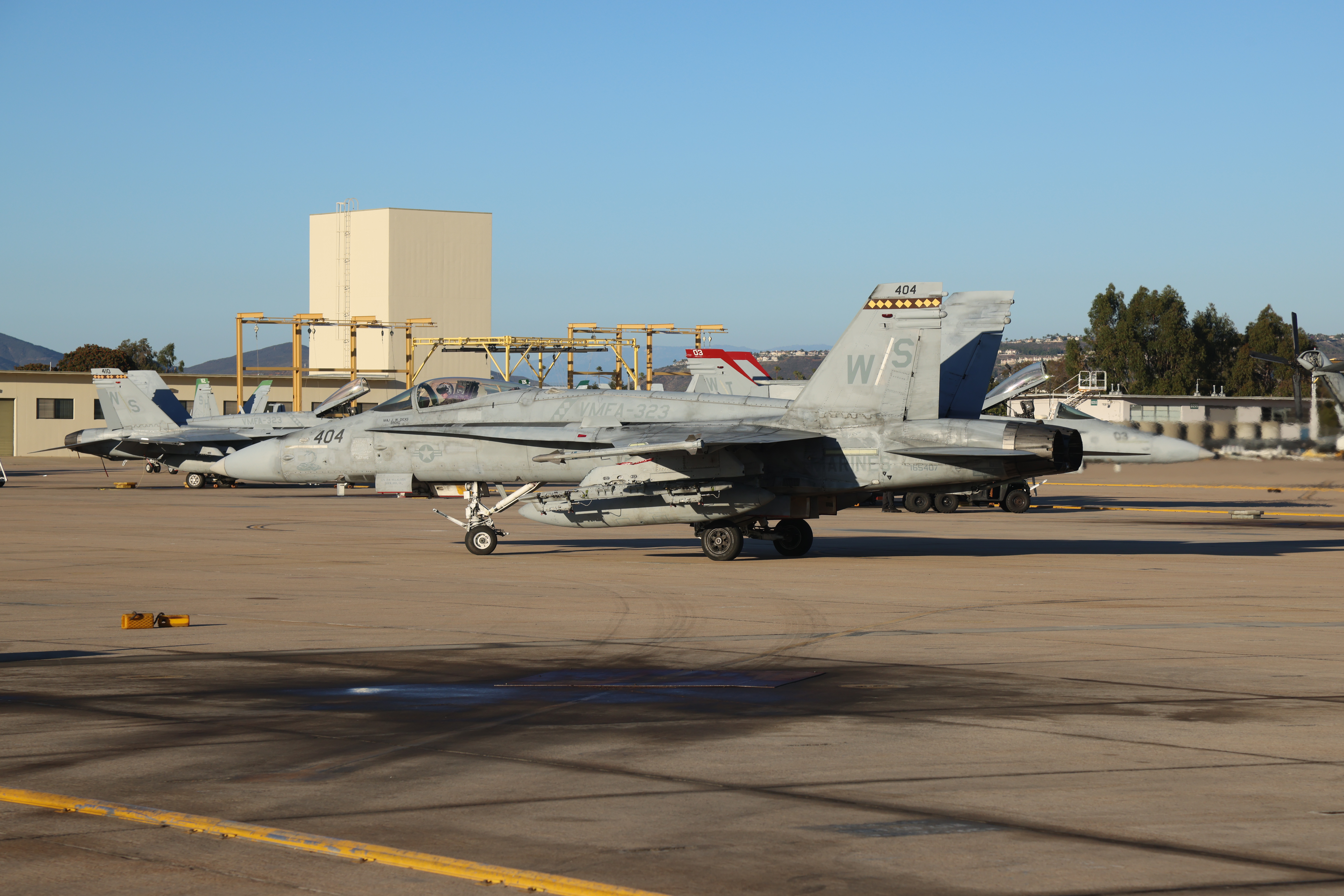
“We provided OCA (Offensive Counter Air) support to our 4th generation brothers and sisters doing a lot of fighter integration off the coast of southern California and Mexico. We are finding out that the legacy Hornet still has a ton of life in it and it’s a very viable platform. Turns out the F/A-18 is very good at naval operations which should not be a shock to anybody,” Guyette said.
“The F/A-18 combined with the F-35 in OCA escort is one of those situations where one plus one equals three as opposed to two. Using the F-35 to sense and make sense of the air picture and the surface picture and transfer that information to the F-18s or backwards to our C2 nodes, we [have] develop[ed] this potent sea denial control capability,” he noted.
VMX-1 uses events like Steel Knight to conduct experimentation with units like the Marine Warfighting Lab because as Guyette explained, “It provides a unique venue because we have so many assets in close proximity to each other that are conducting operationally representative missions. It’s like a big scrimmage and when you have everyone together, there is a huge opportunity to collect really valuable data that we would not be able to capture by ourselves.”
Teaming up with the Marine Corps Warfighting Lab and MAG-39 during the exercise, VMX-1 used their MV-22 in an experiment that gives the MV-22 an anti-submarine warfighting capability known as ‘Blue Crayons.’ The thought is that the MV-22 can bridge the gap between the Navy H-60s and their P-8s.
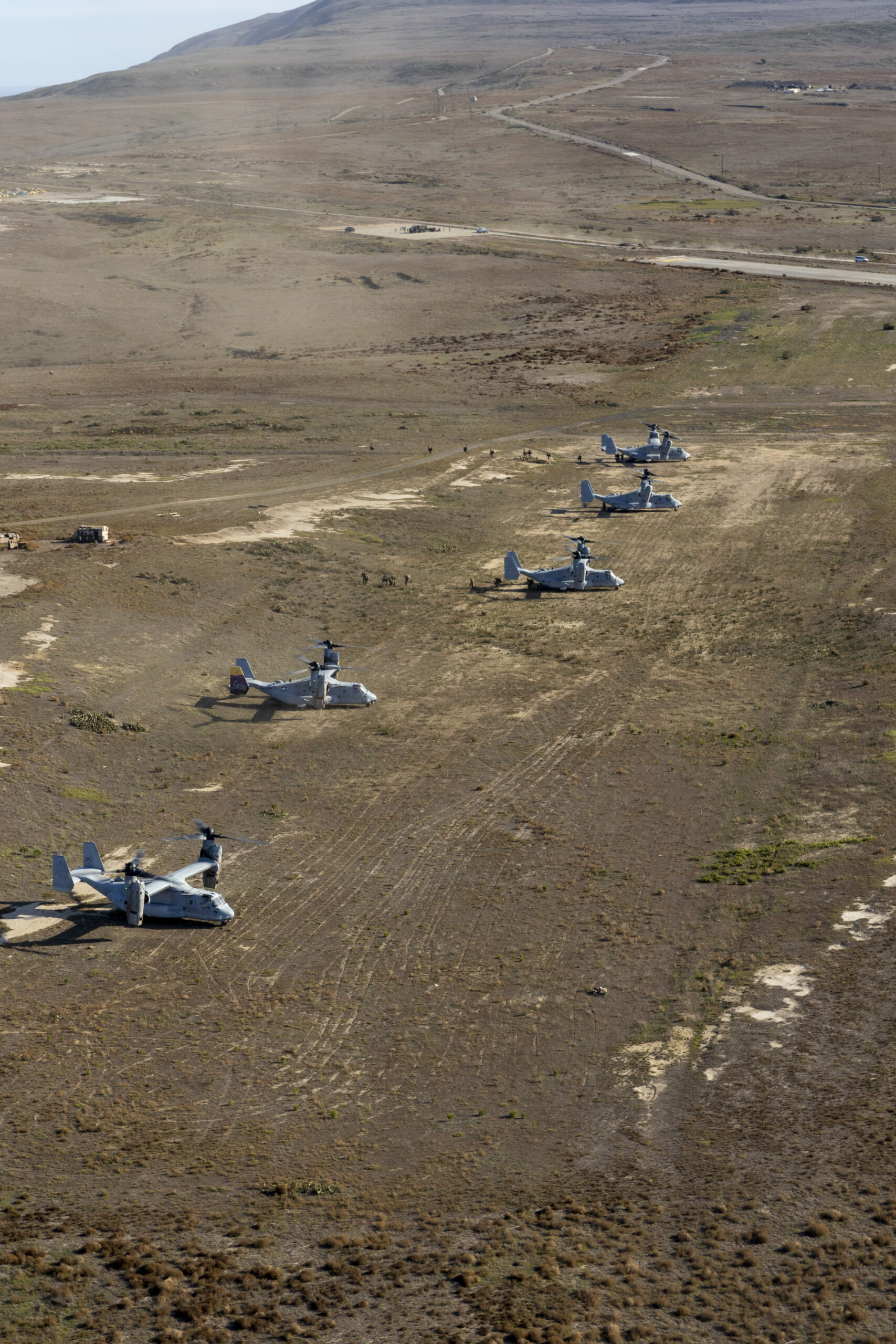
“The MV-22 was used to lay down sonobuoy nets and then interfaced with the sonobuoys in the water,” Guyette told The War Zone. “Our crews have been working really hard with the P-8s and HSC guys to learn how to do that mission. We had undersea targets to work with. We had to figure out how to get the sonobuoys out of the aircraft safely and then [figure out] how … you build out a payload in the MV-22 to interact with the sonobuoys. As part of Steel Knight there were multiple undersea targets that were available to us and we prosecuted those targets using MV-22s delivering sonobuoys controlled onboard and integrating with our Navy brothers and sisters.”
One of the longer and more logistically complex missions during the exercise came from VMFA-314 which is the first USMC F-35C squadron. The squadron recently returned from its first deployment on board the USS Abraham Lincoln and was participating in an exercise in Hawaii. The squadron was tasked with flying from Joint Base Hickam in Hawaii to drop simulated munitions on San Clemente island off the coast of San Diego.

One of the pilots on the mission was the squadron’s executive officer Lieutenant Colonel Michael ’Goonch’ Fisher. Fisher told The War Zone, “We were out in Hawaii participating in exercise Pacific Edge which is a joint partner nation integration event. We worked a multitude of mission sets with the Australian E-7 Wedgetail among others. For the long-range strike, we had two F-35Cs take off and perform a 2,300-mile long-range strike that lasted over six hours. Three VMGR-352 KC-130Js dragged us across the Pacific where we practiced multiple comm[unication] pathways and kill chains to achieve a desired target. The target was passed via subsurface, surface, and airborne communication pathways where we simulated dropping AGM-154 JSOW against a surface target.”
The Commandant has charged the whole Marine Corps to innovate and come up with ideas and unique solutions to hard problems and the service is rapidly accelerating its pace of innovation. Guyette said it best when he told us ”We are all looking for new solutions to tomorrow’s problems because that is how we are going to win.” Steel Knight was squarely targeted at putting some of those potential solutions to the test.
Contact the editor: Tyler@thedrive.com
